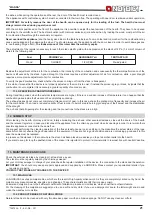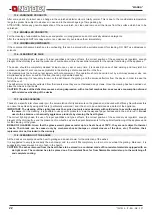
16
3. INSTALLATION REGULATIONS
Installation of the product and auxiliary equipment in relation to the heating system must comply with all current Standards and Regulations
and to those envisioned by the law.
The installation and the relating to the connections of the system, the commissioning and the check of the correct functioning must
be carried out in compliance with the regulations in force by authorised professional personnel with the requisites required by the law,
being national, regional, provincial or town council present in the country within which the appliance is installed, besides these present
instructions.
Installation must be carried out by authorised personnel who must provide the buyer with a system declaration of conformity and will
assume full responsibility for final installation and as a consequence the correct functioning of the installed product.
Before installing the appliance, carry out the following checks:
• Canalization of the warm air (see chapter Canalization).
• Make sure that the floor can support the weight of the appliance, and if it is made of flammable material, provide suitable insulation.
• Make sure that there is adequate ventilation in the room where the appliance is to be installed.
• Do not install the appliance in rooms containing collective ventilation ducts, hoods with or without extractor, type B gas appliances,
heat pumps, or other appliances that, operating at the same time, can put the room in depression (ref.
UNI
10683/98
standard
)
• Make sure that the flue and the pipes to which the appliance will be connected are suitable for its operation.
• The diameter of the opening for connection to the chimney must at least correspond to the diameter of the flue gas pipe. The
opening must be equipped with a wall connection for the insertion of the exhaust pipe and a rosette.
LA NORDICA S.p.A. declines all responsibility for damage to things and/or persons caused by the system. In addition, it is not
responsible for any product modified without authorisation and even less for the use of non original spare parts.
Your regular local chimney sweep must be informed about the installation of the appliance so that he can check the correct connection to
the chimney.
4. FIRE SAFETY
When installing the product, the following safety measures must be observed:
a) In order to ensure sufficient thermal insulation, respect the minimum safety distance from objects or furnishing components
flammable and sensitive to heat (furniture, wood sheathings, fabrics. etc.) and from materials with flammable structure (see
-
A
).
All the minimum safety distances are shown on the product data plate and lower values must not
be used
.
b) in front of the furnace door, in the radiation area, there must be no flammable or heat-sensitive objects or material at a distance of
less than
100 cm
. This distance can be reduced to 40 cm where a rear-ventilated, heat-resistant protection device is installed in
front of the whole component to protect.
c) If the product is installed on a non totally refractory floor, one must foresee a fireproof background.
The floors made of inflammable
material
, such as moquette, parquet or cork etc.,
must be replaced
by a layer of no-inflammable material, for instance ceramic,
stone, glass or steel etc. (dimensions according to the local regulations). The base must extend at least
50 cm
at the front and at
least
30 cm
at the sides, in addition to the opening of the loading door (see
B
).
d) no flammable components (e.g. wall units) must be present above the product.
The Product must always operate exclusively with the ash drawer inserted. The solid combustion residues (ash) must be collected in a
sealed, fire resistant container. The Product must never be on in the presence of gaseous emissions or vapours (for example glue for
linoleum, petrol etc.). Never deposit flammable materials near the Product.
During combustion, thermal energy is released which leads to considerable heating of the surfaces, doors, handles, controls, glass parts,
the flue gas pipe and possibly the front part of the appliance.
Avoid contact with these elements unless using suitable protective
clothing or accessories
(heat resistant gloves, control devices).
Ensure children are aware of these dangers and keep them away from the furnace when it is on.
When using the wrong fuel or one which is too damp, due to deposits present in the flue, a flue fire is possible.
4.1. IN A EMERGENCY
If there is a fire in the flue connection :
a) Close the loading door and the ash drawer door
b) Close the comburent air registers
c) Use carbon dioxide ( CO
2
powder ) extinguishers to put out the fire
d) Request the immediate intervention of the Fire Brigade
DO NOT PUT OUT THE FIRE WITH WATER.
When the flue stops burning, have it checked by a specialist to identify any cracks or permeable points.
















































